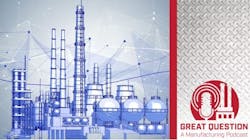Podcast: Navigating reshoring in 2025 amid tariff and trade uncertainty
As if U.S. manufacturers didn’t have enough stressors—tariffs and ensuing trade and supply chain turmoil, the pressure placed on them by digital transformation, cybersecurity concerns, labor difficulties—they’re trying to navigate all this during the push to reshore their operations.
Webinar replay: Revamping your supply chain
Reshoring: That is one of the purposes of the tariffs stated by Donald Trump, and during this episode of Great Question: A Manufacturing Podcast, Plant Services chief editor Thomas Wilk enlisted Rosemary Coates for a discussion on how reshoring efforts in the U.S. are going since Trump took over again in January.
Coates is the executive director of the Reshoring Institute and has experience in global supply chain management consulting at Blue Silk Consulting. She has more than 30 years of experience in supply chain, reshoring and nearshoring, and is the author of several books.
Below is an edited excerpt from the podcast:
About the Podcast
Great Question: A Manufacturing Podcast offers news and information for the people who make, store, and move things and those who manage and maintain the facilities where that work gets done. Manufacturers from chemical producers to automakers to machine shops can listen for critical insights into the technologies, economic conditions, and best practices that can influence how to best run facilities to reach operational excellence.
Thomas Wilk: It has been some six months, hasn't it?
Rosemary Coates: Yeah, like no other six months.
TW: Well, I want to start with something we talked about in January, and when we talked at that time, we were sort of looking forward to what this new administration might hold for reshoring manufacturing.
You said there had been already a significant impact in uptake and reshoring interest and to quote you, you said “phones were ringing.” So, my question right now is: Are the phones still ringing with you and the institute, and if so, what are companies looking for help with these days?
RC: Yeah, for sure, they're ringing! A lot of companies, though, now are in a situation where they're trying to figure out what to do about the tariffs. Since the Trump administration began, the president has signed 143 executive orders related to trade.
And trying to keep that stuff straight, what's on, what's off, what the tariff rate is and so forth, has really gotten to be extremely complicated and tough to keep up with for sure. So yeah, a lot of companies are reaching out to us for help and to try to rethink their strategies.
TW: Interesting. Yeah, the on-again-off-again business has been tough for reporters, too. We keep a running digest of activity on IndustryWeek (a sister brand to Smart Industry and Plant Services), and I found a couple of tables here and there of legal firms keeping track of what's on and what's off. What's on right now, from what I can remember, is 10% across the board with a couple of higher rates here and there, with some things maybe pending in July, right?
See also: Ready to reshore? Surveys show hurdles to returning more manufacturing to U.S.
RC: Yeah, so the original tariffs went into effect about three months ago. Those were the big tariffs, the 145% on China and 46% on Vietnam, and you know, just big tariffs with big numbers.
And then those were put on pause until July 9. If that pause is lifted, we may go back to these giant tariffs again, or there may be a delay or there may be another pause—we just don't know. And it’s really hard to tell whether this is policy or it's more performative politics.
Webinar replay: As tariff war whipsaws world economy, ‘uncertainty is the new certainty'
It's a negotiating tactic that Trump likes to use. In the meantime, it's like a bullwhip effect in business. I mean, it's like on-again-off-again, you know, what do we do? How do we plan for this? And that's the anathema of most businesses, is unpredictability and not knowing what to do.
TW: One report I read was looking at manufacturing construction spending having leveled out year over year in April, after going up pretty quickly year over year in 2024 close to plus-20%. The past year, it's at about plus-1% and the reasons people gave were: high interest rates, increase in construction material prices, and “the overarching economic uncertainty,” right, like “what the heck is going to happen with policy?” Is that the kind of help that people are asking you for? To ask how to navigate this or what the institute thinks might be next?
RC: Two years ago, I was talking about the manufacturing super cycle. We have had so much infusion of capital into the industrial marketplaces, and we were seeing a lot of building, a lot of planning for the future and so forth.
See also: Taking a technological approach to blunt the punch from tariffs
Now I think there's so much uncertainty, that people are stuck. So, for example, we did a project for the state of New York where they asked us to interview 18 executives, all at the C-level, so CEOs, COOs, and chief supply chain officers across America. We did that across geographies. We interviewed these high-level executives and medium-sized businesses and some large businesses. And we asked them, what are you doing now? How are you responding?
And almost to a person they told us they were doing nothing. They were making no investments, they were not opening new factories, they were not hiring—nothing until the economy stabilized a little bit. But in the background, they were feverishly working on plans. We always encourage our clients to have a plan A, B, and C.
Because of the instability of the world right now, you never know when a new war is going to break out or a new pandemic or something, so you need to have a lot of alternate plans. And that's what these executives told us, that they were actually working on multiple plans, multiple alternative ways to address the variability in the environment right now.
So, they're stuck, they're not making investment in new properties, they're not building anything right now. But hopefully, when things stabilize and we don't have these wild swings and tariffs and these crazy geopolitics going on, then they'll put the foot on the gas, and we'll see some big investment going on.
About the Author
Scott Achelpohl
Head of Content
I've come to Smart Industry after stints in business-to-business journalism covering U.S. trucking and transportation for FleetOwner, a sister website and magazine of SI’s at Endeavor Business Media, and branches of the U.S. military for Navy League of the United States. I'm a graduate of the University of Kansas and the William Allen White School of Journalism with many years of media experience inside and outside B2B journalism. I'm a wordsmith by nature, and I edit Smart Industry and report and write all kinds of news and interactive media on the digital transformation of manufacturing.

